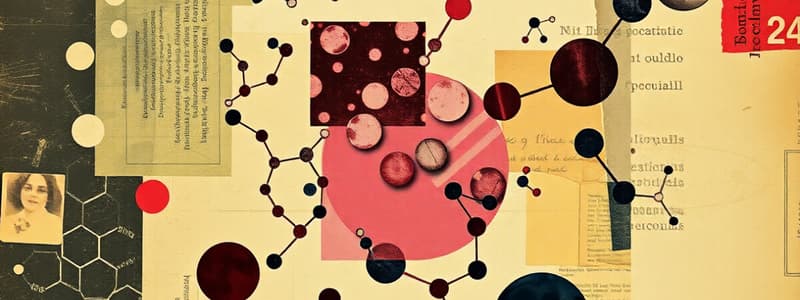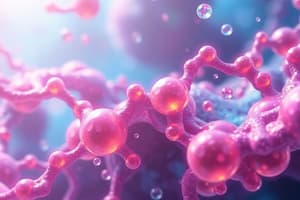Podcast
Questions and Answers
What is the definition of a lipid?
What is the definition of a lipid?
A lipid is an organic compound found in living organisms that is insoluble (or only sparingly soluble) in water but soluble in non-polar organic solvents.
Which of the following is not a defining characteristic of lipids?
Which of the following is not a defining characteristic of lipids?
- They are classified based on their solubility.
- They are soluble in non-polar organic solvents.
- They are insoluble in water.
- They have a common structural feature. (correct)
Which of the following is not a category of lipids based on their function?
Which of the following is not a category of lipids based on their function?
- Energy-storage lipids
- Hormonal lipids (correct)
- Protective-coating lipids
- Membrane lipids
Which of these is a general characteristic of fatty acids?
Which of these is a general characteristic of fatty acids?
What is the difference between a saturated and an unsaturated fatty acid?
What is the difference between a saturated and an unsaturated fatty acid?
What determines the melting point of a fatty acid?
What determines the melting point of a fatty acid?
What is the name of the most common energy-storage lipid in the body?
What is the name of the most common energy-storage lipid in the body?
Trilacylglycerols are always composed of three identical fatty acid chains.
Trilacylglycerols are always composed of three identical fatty acid chains.
What distinguishes fats from oils in terms of physical properties?
What distinguishes fats from oils in terms of physical properties?
The typical American diet is considered to be deficient in omega-3 fatty acids.
The typical American diet is considered to be deficient in omega-3 fatty acids.
What is the primary function of phospholipids in the cell?
What is the primary function of phospholipids in the cell?
Glycerophospholipids have four ester linkages, while triacylglycerols have three ester linkages.
Glycerophospholipids have four ester linkages, while triacylglycerols have three ester linkages.
Sphingophospholipids and glycerophospholipids are both polar molecules.
Sphingophospholipids and glycerophospholipids are both polar molecules.
Which of these is not a function of cholesterol in the body?
Which of these is not a function of cholesterol in the body?
The human body can synthesize sufficient cholesterol from dietary intake.
The human body can synthesize sufficient cholesterol from dietary intake.
What is the name of the structure that surrounds cells and separates their internal environment from the external environment?
What is the name of the structure that surrounds cells and separates their internal environment from the external environment?
What is the primary function of proteins in the cell membrane?
What is the primary function of proteins in the cell membrane?
Which type of transport across the cell membrane requires the expenditure of energy?
Which type of transport across the cell membrane requires the expenditure of energy?
What is the name of the substance that can disperse and stabilize water-insoluble substances as colloidal particles in an aqueous solution?
What is the name of the substance that can disperse and stabilize water-insoluble substances as colloidal particles in an aqueous solution?
What is the primary function of bile acids in the digestive system?
What is the primary function of bile acids in the digestive system?
Steroid hormones are all derived from cholesterol.
Steroid hormones are all derived from cholesterol.
Match the following hormones with their primary function:
Match the following hormones with their primary function:
What is the primary function of adrenocorticoid hormones?
What is the primary function of adrenocorticoid hormones?
Eicosanoids are hormone-like molecules that are synthesized in the tissues where they exert their primary effects.
Eicosanoids are hormone-like molecules that are synthesized in the tissues where they exert their primary effects.
Which of the following is not a type of eicosanoid?
Which of the following is not a type of eicosanoid?
What is the primary function of biological waxes in a plant?
What is the primary function of biological waxes in a plant?
Flashcards
Lipid
Lipid
An organic compound found in living organisms that is insoluble (or only sparingly soluble) in water but soluble in non-polar organic solvents.
Lipid Classification
Lipid Classification
Lipids are classified based on solubility, not functional groups.
Energy-storage lipids
Energy-storage lipids
Triacylglycerols are the primary example of energy-storage lipids.
Membrane lipids
Membrane lipids
Signup and view all the flashcards
Fatty acids
Fatty acids
Signup and view all the flashcards
Saturated fatty acids
Saturated fatty acids
Signup and view all the flashcards
Unsaturated fatty acids
Unsaturated fatty acids
Signup and view all the flashcards
Monounsaturated fatty acid
Monounsaturated fatty acid
Signup and view all the flashcards
Polyunsaturated fatty acid (PUFA)
Polyunsaturated fatty acid (PUFA)
Signup and view all the flashcards
Omega-3 fatty acid
Omega-3 fatty acid
Signup and view all the flashcards
Omega-6 fatty acid
Omega-6 fatty acid
Signup and view all the flashcards
Triacylglycerols
Triacylglycerols
Signup and view all the flashcards
Simple triacylglycerol
Simple triacylglycerol
Signup and view all the flashcards
Mixed triacylglycerol
Mixed triacylglycerol
Signup and view all the flashcards
Fats
Fats
Signup and view all the flashcards
Oils
Oils
Signup and view all the flashcards
Melting point
Melting point
Signup and view all the flashcards
Dietary fat
Dietary fat
Signup and view all the flashcards
Essential Fatty Acids
Essential Fatty Acids
Signup and view all the flashcards
Dietary Considerations
Dietary Considerations
Signup and view all the flashcards
Study Notes
Chapter 19: Lipids
- Lipids are organic compounds found in living organisms
- Lipids are generally insoluble in water but soluble in nonpolar organic solvents
- Lipids are diverse in structure, not unified by a common structural feature
- Five main categories of lipids are defined based on their function
- Energy-storage lipids (triacylglycerols)
- Membrane lipids (phospholipids, sphingoglycolipids, cholesterol)
- Emulsification lipids (bile acids)
- Chemical messenger lipids (steroid hormones, eicosanoids)
- Protective-coating lipids (biological waxes)
19.1 Structure and Classification of Lipids
- Lipids are classified based on their solubility
- Insoluble or sparingly soluble in water
- Soluble in nonpolar organic solvents
19.2 Types of Fatty Acids
- Fatty acids are naturally occurring monocarboxylic acids
- Saturated fatty acids have only single C-C bonds
- Unsaturated fatty acids have one or more C=C double bonds
- Monounsaturated have one double bond
- Polyunsaturated have two or more double bonds
- Fatty acid chains are usually linear (unbranched)
- Number of carbon atoms is often even
- The location of the double bonds (i.e., omega 3, omega 6) is important in their function
19.3 Physical Properties of Fatty Acids
- Water solubility varies with chain length; short chains are somewhat soluble, long chains are insoluble
- Melting point depends on chain length and degree of unsaturation; shorter chains and more unsaturated chains have lower melting points
19.4 Energy-Storage Lipids: Triacylglycerols
- Triacylglycerols (triglycerides) are the main energy storage lipids of animals
- Glycerol molecule esterified with 3 fatty acid chains.
- They are stored in specialized cells called adipocytes.
19.5 Dietary Considerations and Triacylglycerols
- Diets high in fats/oils are linked to increased heart disease and certain cancers
- Americans are encouraged to reduce their fat intake.
- Recommendations are given on portion amounts of unsaturated, saturated and polyunsaturated fats for different nutrients.
19.6 Chemical Reactions of Triacylglycerols
- Hydrolysis is the partial breakdown of triacylglycerols
- Breaking of ester bonds to yield mono- or diacylglycerols and fatty acids
- Saponification is the complete hydrolysis of a triacylglycerol in a basic solution
- Produces soap (a salt of a fatty acid) and glycerol.
- Hydrogenation adds hydrogen to unsaturated fatty acids to increase the degree of saturation
- Converts oils into solid fats
19.7 Membrane Lipids: Phospholipids
- Phospholipids are major components of cell membranes.
- Contain a glycerol backbone, two fatty acid chains, a phosphate group, and a polar group.
- Form bilayers in cell membranes.
19.8 Membrane Lipids: Sphingolipids
- Sphingolipids are structurally related to sphingosine, an 18 carbon long unsaturated amino alcohol.
- Often contain a carbohydrate chain.
- Types: Cerebrosides, gangliosides - Important components of nerve tissue and cell membranes, particularly in the brain.
19.9 Membrane Lipids: Cholesterol
- Cholesterol is a steroid lipid.
- Important component of cell membranes, and in the synthesis of hormones and vitamins.
- A lipid with a fused ring structure that is crucial for normal function in animals.
19.10 Cell Membranes
- Cell membranes are composed of a phospholipid bilayer, which is a double layer of phospholipids.
- The membrane also contains proteins for active transport
- Cholesterol molecules help regulate the fluidity of cell membranes.
19.11 Emulsification Lipids: Bile Acids
- Bile acids are cholesterol derivatives that function as emulsifiers
- They aid in the digestion of fats by dispersing them in aqueous solutions.
19.12 Messenger Lipids: Steroid Hormones
- Steroid hormones are derived from cholesterol
- These hormones regulate various processes in the body (sexual and metabolic processes).
- Types: Estrogens, androgens, progestins
19.13 Messenger Lipids: Eicosanoids
- Eicosanoids are a diverse group of molecules derived from fatty acids.
- Involved in inflammation, pain, fever, blood clotting, reproduction, and other functions.
- Types: Prostaglandins, thromboxanes, leukotrienes.
19.14 Protective-Coating Lipids: Biological Waxes
- Waxes are esters of long-chain fatty acids and long-chain alcohols.
- Repellent to water and protect surfaces of plants and animals in various ways.
Studying That Suits You
Use AI to generate personalized quizzes and flashcards to suit your learning preferences.




